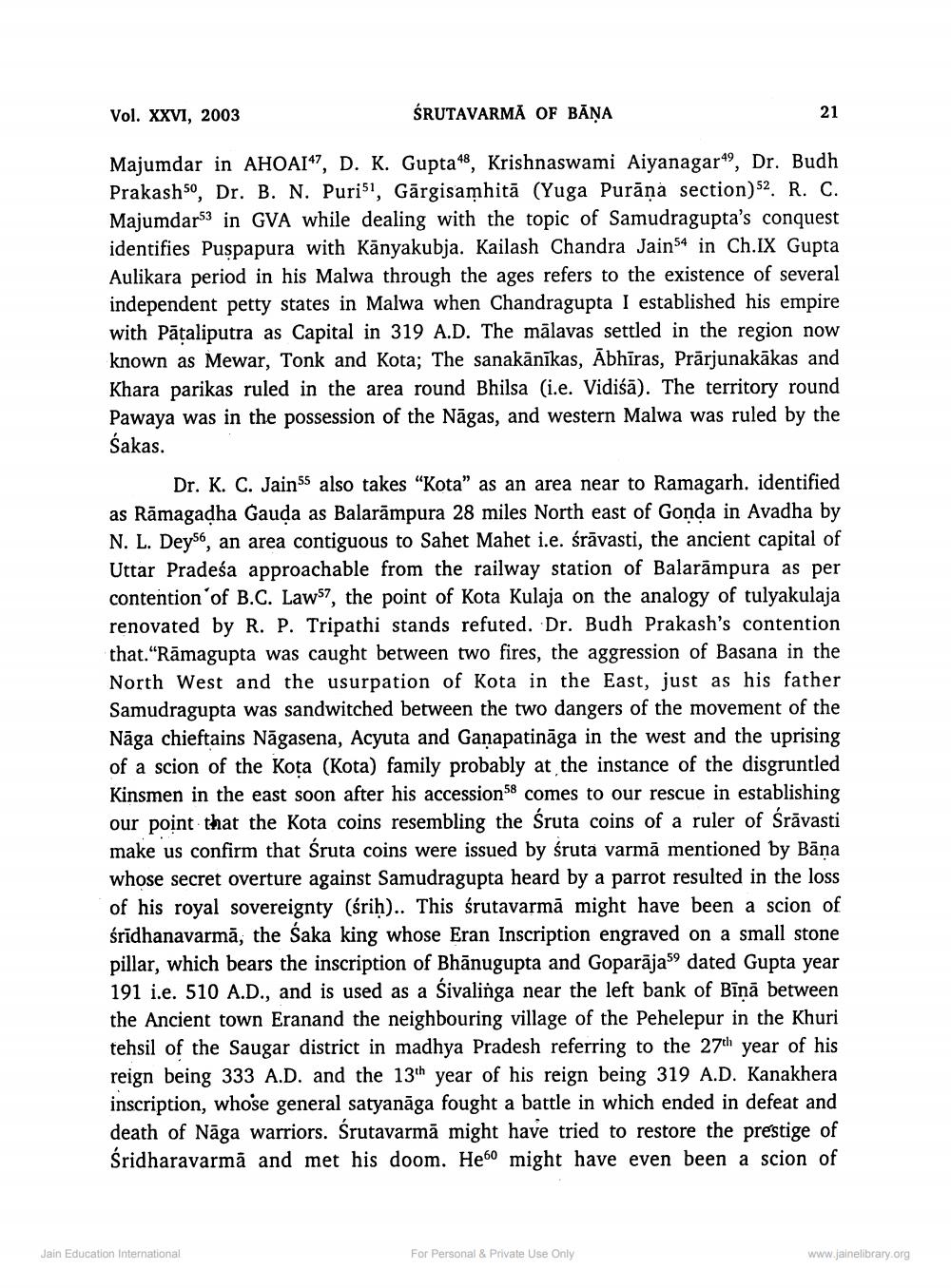________________
Vol. XXVI, 2003
ŚRUTAVARMA OF BĀŅA
Majumdar in AHOAI“?, D. K. Gupta48, Krishnaswami Aiyanagaroo, Dr. Budh Prakashso, Dr. B. N. Purisi, Gārgisamhitā (Yuga Purāņa section)52. R. C. Majumdars3 in GVA while dealing with the topic of Samudragupta's conquest identifies Puspapura with Känyakubja. Kailash Chandra Jain54 in Ch.IX Gupta Aulikara period in his Malwa through the ages refers to the existence of several independent petty states in Malwa when Chandragupta I established his empire with Pātaliputra as Capital in 319 A.D. The mālavas settled in the region now known as Mewar, Tonk and Kota; The sanakānīkas, Abhiras, Prārjunakākas and Khara parikas ruled in the area round Bhilsa (i.e. Vidiśā). The territory round Pawaya was in the possession of the Nāgas, and western Malwa was ruled by the Śakas.
Dr. K. C. Jains also takes "Kota” as an area near to Ramagarh. identified as Rāmagadha Gauda as Balarāmpura 28 miles North east of Gonda in Avadha by N. L. Deys6, an area contiguous to Sahet Mahet i.e. śrāvasti, the ancient capital of Uttar Pradeśa approachable from the railway station of Balarāmpura as per contention of B.C. Laws7, the point of Kota Kulaja on the analogy of tulyakulaja renovated by R. P. Tripathi stands refuted. Dr. Budh Prakash's contention that. “Rāmagupta was caught between two fires, the aggression of Basana in the North West and the usurpation of Kota in the East, just as his father Samudragupta was sandwitched between the two dangers of the movement of the Nāga chieftains Nāgasena, Acyuta and Ganapatināga in the west and the uprising of a scion of the Kota (Kota) family probably at the instance of the disgruntled Kinsmen in the east soon after his accession 58 comes to our rescue in establishing our point that the Kota coins resembling the Śruta coins of a ruler of Śrāvasti make us confirm that śruta coins were issued by śruta varmā mentioned by Bāna whose secret overture against Samudragupta heard by a parrot resulted in the loss of his royal sovereignty (śrih).. This śrutavarmā might have been a scion of śrīdhanavarmā, the Saka king whose Eran Inscription engraved on a small stone pillar, which bears the inscription of Bhānugupta and Goparājas dated Gupta year 191 i.e. 510 A.D., and is used as a Sivalinga near the left bank of Bīnā between the Ancient town Eranand the neighbouring village of the Pehelepur in the Khuri tehsil of the Saugar district in madhya Pradesh referring to the 27th year of his reign being 333 A.D. and the 13th year of his reign being 319 A.D. Kanakhera inscription, whose general satyanāga fought a battle in which ended in defeat and death of Nāga warriors. śrutavarmā might have tried to restore the prestige of Śridharavarma and met his doom. He might have even been a scion of
Jain Education International
For Personal & Private Use Only
www.jainelibrary.org




